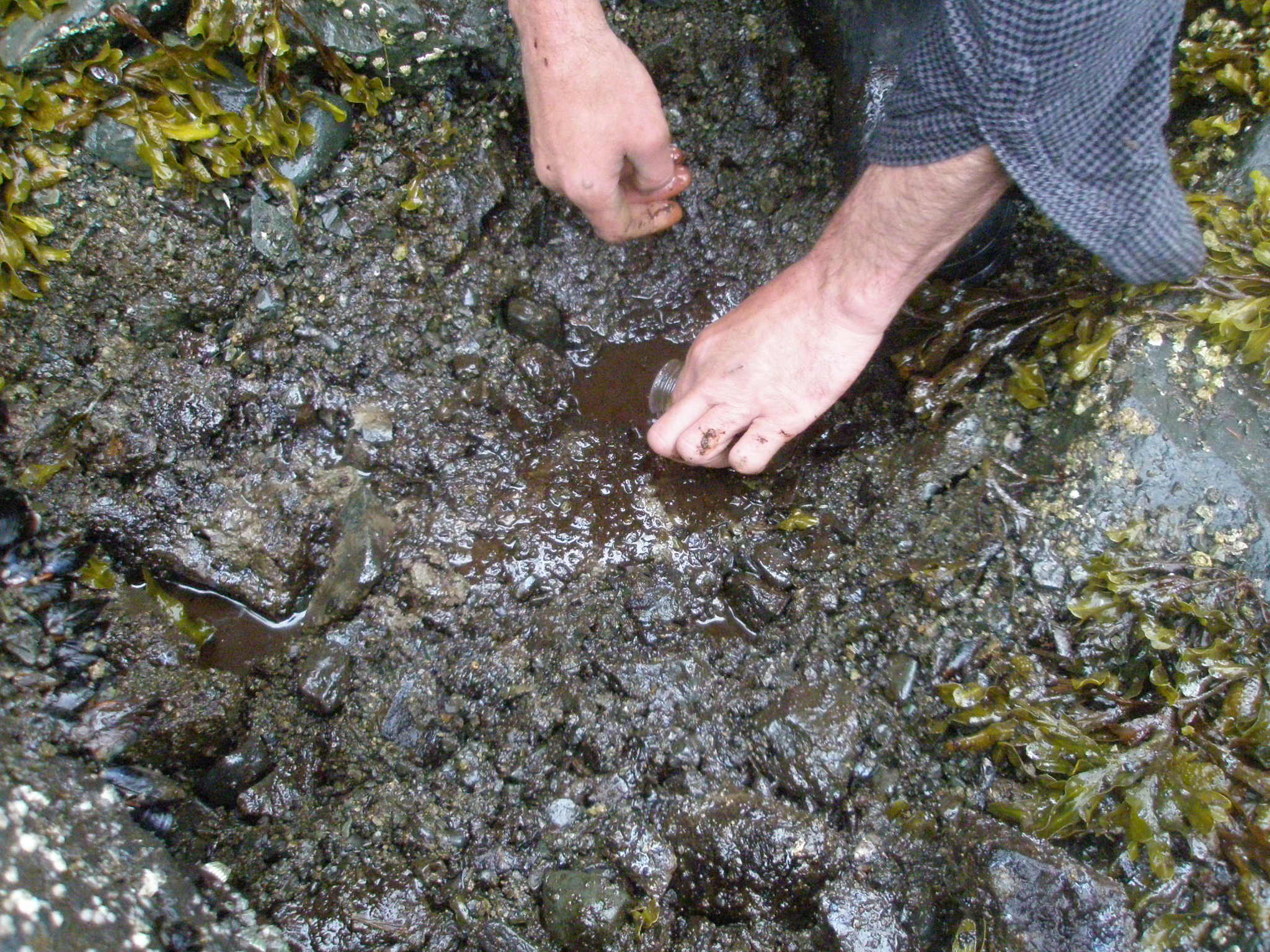28 October 2010
Beaches can harbor hidden oil long after spills
Posted by koneil

Collecting oil from a shallow pit on a beach on Knight Island, Alaska. (Photo courtesy of the researchers.)
Crude oil from a spill can remain trapped for decades under a beach’s surface. A 2001 survey of beaches along Alaska’s Prince William Sound estimated that about 100 tons of oil from the 1989 Exxon Valdez spill remained in the beaches’ lower layers, and much of it is still there, researchers say. A new study of one of those beaches found that the reason the oil becomes trapped in the subsurface layers is due to the fresh water that flows through and under the beach.
The researchers also investigated a possible means of speeding up the biological breakdown of the hidden oil by applying nutrients at depths that would reach the oil and promote bacterial growth. While sunlight, oxygen, waves, and bacteria will eventually break down oil at the surface, that degradation isn’t happening in the beaches’ lower layers.
Michel Boufadel, civil and environmental engineering professor at Temple University, led a hydrologic study of a rocky beach in Alaska’s Prince William Sound that had been affected by the 1989 Valdez oil spill. He and his colleagues tracked the fresh and saltwater flows through the beach at various depths. They found that when subsurface flows of freshwater from land dropped, oil floating on that water followed and become trapped in the beach’s lower layers, where it still persists 21 years after the spill.
The trapped oil remains a source of contamination, he said. Wildlife including sea otters, sea ducks and other birds can become directly exposed to the oil as they, while and smaller organisms are affected by the chemicals that seep into the water and surrounding environment.
Gravel beaches are more permeable in their upper layers, but usually have a lower layer of sediment that is much less permeable about 1 to 2 feet (about 0.5 meters) below the surface. It’s there that oil can become trapped, and break down very slowly. A 2007 study estimated that subsurface oil from the Valdez spill was breaking down at a rate of about 4 percent per year, meaning it would remain for decades more.
Boufadel said he hopes these findings are considered if oil tankers are to begin carrying crude oil through the Northwest Passage, as may become possible due to recent reductions in Arctic Sea ice during the summer season.
“It’s important because these beaches are more susceptible to damage from an oil spill than sandy beaches, because the oil can get down lower and remain trapped,” he said.
Beaches with higher flows of freshwater reaching ocean through their underground layers are less likely to have trapped oil there, since the oil will remain on top of the water. However, Boufadel estimated that about half of the region’s rocky beaches do not have sufficient freshwater flow to prevent oil from becoming trapped.
Once they understood the beach’s hydrology, the researchers used a model to determine whether introducing nutrients to the surface of the beach would be an effective way to speed up bacterial activity and degradation of oil trapped beneath the beach. They concluded that nutrients applied only on the surface would not reach the lower layers or the oil.
“The assumption has been that if you apply nutrients to a beach, it’ll reach the lower layers. But that’s not always true,” Boufadel said. “The natural flushing of the beach is not enough.” One way to encourage the remediation of oil trapped below the beach, he said, would be to dig a shallow well or inject fertilizers into the lower beach layers, where it can stimulate bacterial break-down of the oil.
This technique could be a useful remediation tool for beaches along the Gulf of Mexico that have been affected by the Deepwater Horizon leak, Boufadel said. While the beaches there tend to be sandy and less permeable, so the oil doesn’t penetrate as deep, natural wave action deposits sand over the oil, which hides the contamination and creates the same problems of low nutrients and oxygen. Biodegradation can be used after the initial response of soaking up the oil on the surface has been done, Boufadel said, especially in ecologically-sensitive areas where digging and using machinery would be harmful.
The research was published on October 16 in Water Resources Research, a journal of the American Geophysical Union. Boufadel and a co-author published a related paper in January.
–Kathleen O’Neil, AGU science writer










 GeoSpace is a blog on Earth and space science, managed by AGU’s Public Information staff. The blog features posts by AGU writers and guest contributors on all sorts of relevant science topics, but with a focus on new research and geo and space sciences-related stories that are currently in the news.
GeoSpace is a blog on Earth and space science, managed by AGU’s Public Information staff. The blog features posts by AGU writers and guest contributors on all sorts of relevant science topics, but with a focus on new research and geo and space sciences-related stories that are currently in the news.
[…] Beaches can harbor hidden oil long after spills […]
[…] members of the community, in addition to their three AGU-written blogs, The Plainspoken Scientist, Geospace, and […]